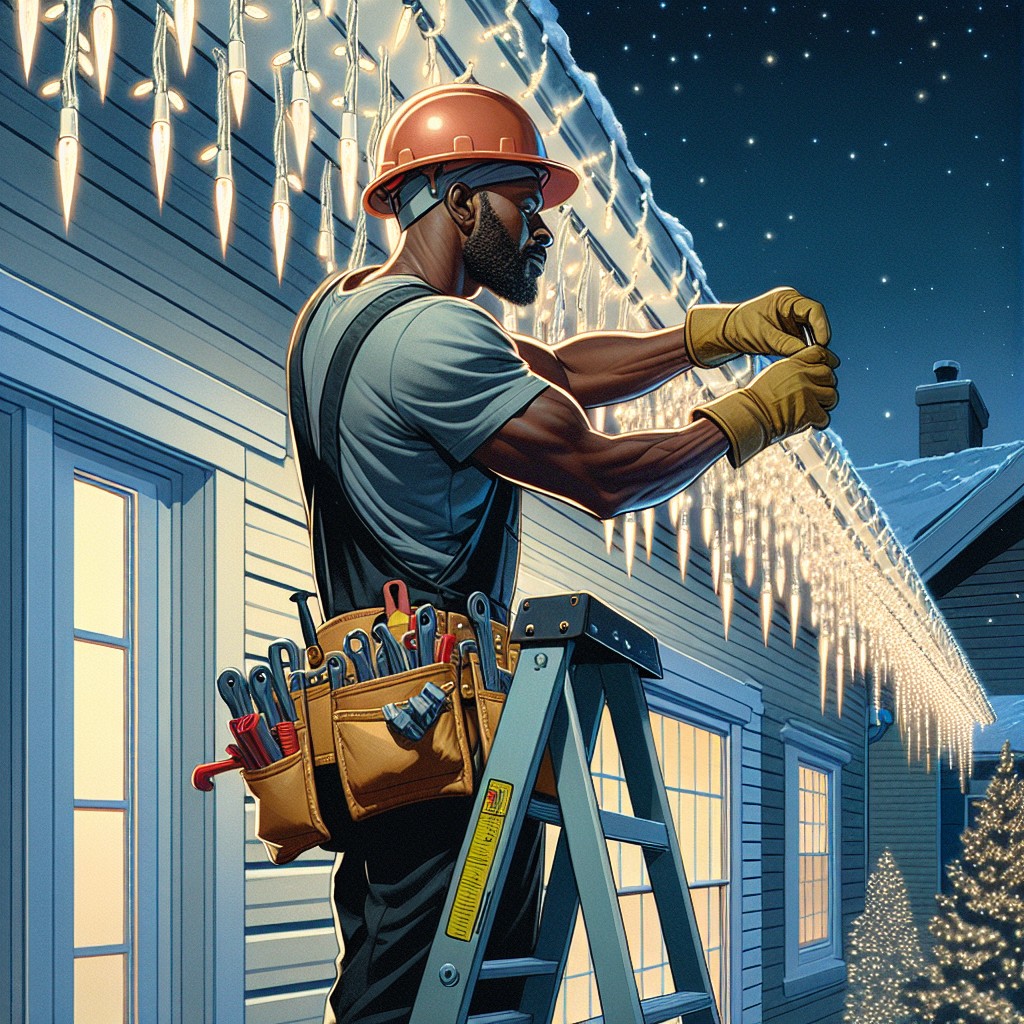Last updated on
Explore the unique beauty and functionality of Chinese roof design ideas, characterized by their curved edges, multi-tier structures, and intricate detailing.
Exploring Chinese roof design ideas can open up a world of architectural beauty and functionality. Known for their unique aesthetics and symbolic meanings, Chinese roofs have been an essential part of the country’s architectural heritage for centuries.
This article will delve into the various design elements that make these roofs stand out, from the sweeping curves of the eaves to the intricate details of the roof tiles.
Whether you’re looking to incorporate these designs into your own home or simply appreciate their artistic value, you’ll find comprehensive insights into Chinese roofing designs here.
Traditional Pagoda-inspired Roofs

Traditional pagoda-inspired roofs are iconic in Chinese architecture. These roofs are characterized by their multi-tiered design, with each tier slightly smaller than the one below it, creating an elegant and distinctive silhouette.
Pagoda roofs usually have upturned eaves, which are curved upwards at the corners, giving them a graceful and uplifted appearance. The sloping ends of the eaves often curve upwards as well, adding to the overall sense of upward movement.
These roofs are typically adorned with intricate carvings and colorful decorations, showcasing the craftsmanship and attention to detail that is a hallmark of Chinese design.
Pagoda-inspired roofs can be seen in various structures, including temples, pavilions, and gardens, and they not only provide shelter but also carry symbolic meaning, representing spiritual ascent and connection to the divine.
Their unique shape and cultural significance make pagoda-inspired roofs a captivating element of Chinese architecture.
Green-roofed Courtyard Houses
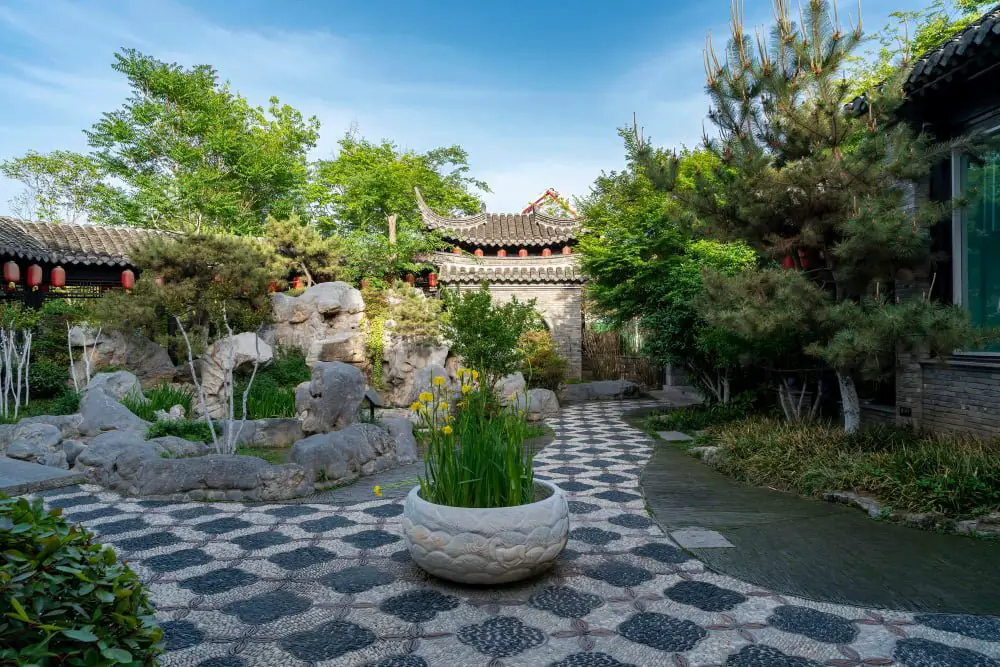
Green-roofed courtyard houses in Chinese architecture offer a harmonious blend of nature and human-made structures. These houses feature roofs that are covered with lush vegetation, providing numerous environmental and aesthetic benefits.
The green roofs not only enhance the visual appeal of the houses but also offer insulation, reducing heat gain in the summer and heat loss in the winter. They also absorb rainwater, reducing the load on drainage systems and helping to mitigate urban heat island effects.
The courtyard design of these houses, combined with the green roof, creates a serene and tranquil living space that connects occupants with nature. Additionally, the vegetation acts as a natural filter, improving air quality and reducing noise pollution.
This combination of eco-friendly elements makes green-roofed courtyard houses a sustainable and beautiful architectural choice in Chinese design.
Circular Rounded Rooftops
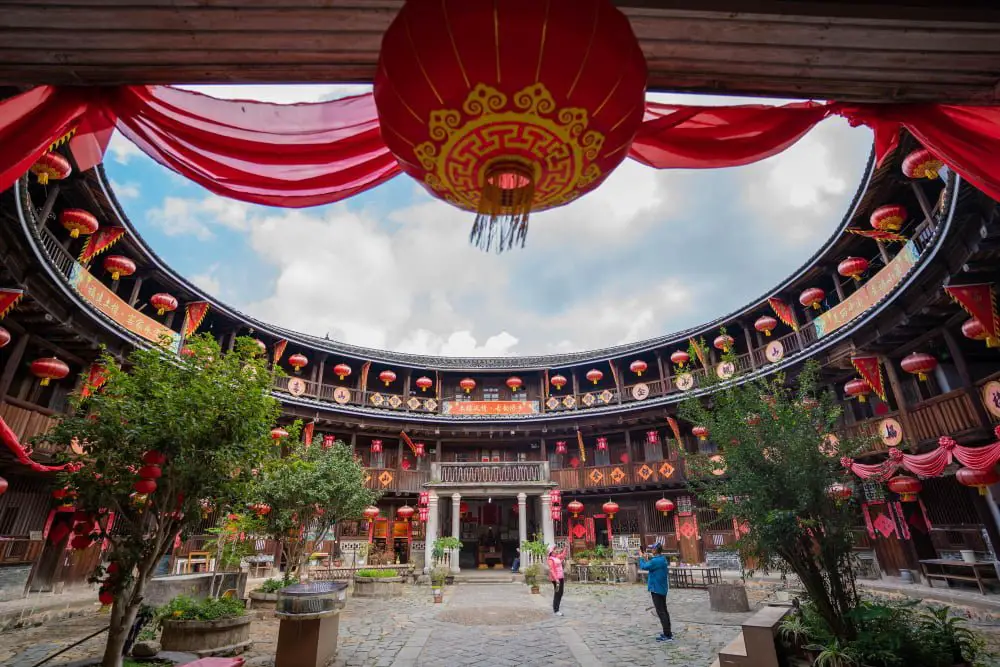
Traditionally seen in Chinese architecture, circular rounded rooftops offer a unique and distinctive design element. These roofs, commonly found in temples, tombs, and some courtyard houses, add an elegant and harmonious touch to the overall structure.
Reflecting the philosophy of balance and harmony in Chinese culture, the rounded shape symbolizes unity and completeness. It also allows for better resistance against strong winds and creates a visually pleasing silhouette.
Circular rounded rooftops exhibit exquisite craftsmanship, often adorned with intricate carvings and vibrant colors, making them a true embodiment of traditional Chinese architectural beauty.
Grand Mansion Roofs With Sweeping Eaves

Grand mansion roofs with sweeping eaves are a hallmark of Chinese architectural excellence. These roofs are characterized by their elegant curvature, which extends beyond the walls of the building to create a graceful, sweeping effect.
The grandeur of these roofs is often enhanced by the use of high-quality materials, such as glazed tiles or intricately carved woodwork. This design not only adds aesthetic appeal to the building, but also serves a practical purpose by providing protection against the elements, particularly heavy rain.
The sweeping eaves effectively direct rainwater away from the walls, preventing moisture damage and contributing to the longevity of the overall structure. This style of roof can be found in both ancient and modern mansions, showcasing the rich architectural heritage and timeless beauty of Chinese roof design.
Bamboo-and-thatch Village Hut Roofs

Bamboo-and-thatch village hut roofs are a charming and eco-friendly roofing option commonly found in rural areas of China. These roofs are constructed using locally sourced bamboo and thatch materials, creating a rustic yet beautiful aesthetic.
The bamboo provides a sturdy framework, while the thatch, typically made from straw or reeds, acts as a natural insulator. This combination of materials ensures excellent thermal regulation, keeping the interior cool in summer and warm in winter.
Furthermore, these roofs are lightweight and easily replaceable, making them cost-effective and sustainable. With their natural appeal and traditional craftsmanship, bamboo-and-thatch village hut roofs showcase the simplicity and harmony often associated with rural Chinese living.
Modern Interpretation of the Imperial Roof

In contemporary Chinese architecture, there is a growing trend towards modern interpretations of the imperial roof design. Architects and designers are inspired by the elegance and sophistication of traditional imperial roofs and seek to incorporate these elements into modern structures.
These modern interpretations often feature sleek lines, minimalist forms, and a fusion of traditional and contemporary materials. By combining the classic elements of the imperial roof with modern architectural techniques, these designs pay homage to Chinese heritage while adding a unique twist.
The result is a harmonious blend of the past and the present, creating visually stunning structures that capture the essence of Chinese architecture in a modern context.
Hipped-gable Roof With Intricate Woodwork

The hipped-gable roof with intricate woodwork is a captivating Chinese roof design that showcases exquisite craftsmanship. This style combines the functional features of a hipped roof with the visual appeal of intricate wood carvings.
The roof design typically features a square or rectangular shape with sloping sides and a gable at each end. These gables are adorned with delicate wooden carvings depicting traditional symbols, mythical creatures, or intricate patterns. The woodwork is meticulously crafted, with attention paid to every detail, resulting in a visually stunning and culturally rich roof design.
The hipped-gable roof with intricate woodwork can be found on various structures, including temples, palaces, and traditional Chinese homes, adding a touch of elegance and cultural significance to the architecture.
Flat Beijing-style Roofs With Sky-wells

Flat Beijing-style roofs with sky-wells: Originating from ancient Chinese architecture, flat rooftops with sky-wells are a distinctive feature of Beijing-style design.
Rather than a conventional sloped roof, these structures have a flat surface with a well-like opening known as a sky-well in the center.
The purpose of the sky-well is to allow natural light and ventilation into the building, creating a bright and airy atmosphere.
Apart from their functional aspect, these sky-wells also add an aesthetic charm to the rooftops.
The flat Beijing-style roofs with sky-wells are commonly seen in traditional courtyard residences, where they serve as a key architectural element.
Today, these roofs continue to be popular in modern interpretations of Chinese architecture, blending tradition and innovation seamlessly.
Tower-like Roofs Found in the South of China

Tower-like roofs are a distinct feature found in the southern regions of China. These roofs are characterized by their tall and imposing structures, often resembling pagodas or watchtowers.
With multiple tiers and intricate details, these roofs showcase the architectural prowess of the region. The design of these tower-like roofs is not only visually striking but also serves a practical purpose.
The height of the roofs helps to promote air circulation, keeping the interiors of the buildings cool in the hot and humid southern climate. This unique design also allows for better water drainage during the rainy seasons.
Overall, tower-like roofs found in the south of China are a captivating sight that marries aesthetics with functionality, exemplifying the rich architectural heritage of the region.
Concealed Roof With a Contemporary Twist

A concealed roof with a contemporary twist combines the sleekness of modern architecture with the subtle elegance of traditional Chinese design. This innovative approach involves hiding the roof structure beneath the building facade, creating a clean and smooth exterior appearance.
By concealing the roof, this design allows for a seamless integration of the building into its surroundings and emphasizes the overall aesthetic appeal. The contemporary twist lies in the use of modern materials and techniques to achieve this concealed effect, such as utilizing lightweight panels or advanced cladding systems.
This unique roofing concept is gaining popularity not only for its visual appeal but also for its practical benefits, such as enhanced energy efficiency and reduced maintenance requirements. The concealed roof with a contemporary twist offers a fresh take on Chinese roof design, blending tradition with modernity in an elegant and understated way.
Bold, Black-tiled Rooftops
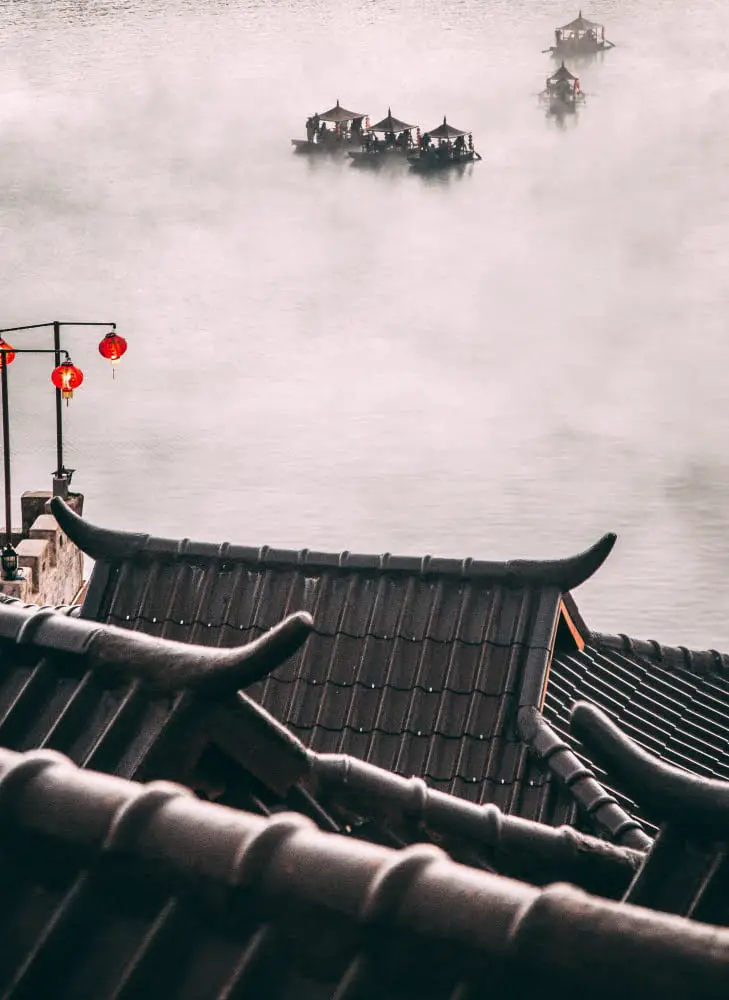
Bold, black-tiled rooftops are a striking feature of traditional Chinese architecture. These dark roofs, often made from materials like slate or stained wood, bring a sense of elegance and sophistication to any structure.
The deep black color contrasts beautifully with the surrounding landscape, creating a visually striking appearance. Black-tiled roofs are commonly found on ancestral halls, temples, and historical buildings, as they are believed to symbolize power, dignity, and authority.
The color black is also associated with water in Chinese culture, which is considered auspicious for attracting prosperity and good fortune. By incorporating bold, black-tiled rooftops into your own architectural designs, you can add a touch of grandeur and time-honored tradition to any building.
Feng Shui Based Roof Design

Feng Shui, an ancient Chinese philosophy, plays a significant role in the design and placement of various elements, including roofs. In Feng Shui, it is believed that the roof design is directly connected to the energy flow, also known as Qi, of a building. A properly designed and aligned roof can enhance positive energy while warding off negative influences.
The key principles of Feng Shui-based roof design include auspicious shapes, colors, and materials. Traditional roof designs often incorporate curved shapes, symbolizing the gentle flow of energy. Colors such as red, symbolizing luck and happiness, and green, representing growth and harmony, are commonly used. Additionally, the materials chosen for the roof, such as clay tiles or wood, are selected based on their natural properties and how they interact with the surrounding environment.
The placement and orientation of the roof in relation to the cardinal directions also play a crucial role in Feng Shui. It is believed that a properly aligned roof can optimize the flow of Qi and bring prosperity, health, and good fortune to the occupants. The precise calculations and considerations involved in determining the ideal roof orientation involve factors such as the building’s location, surrounding landscape, and the birth dates of the occupants.
In modern times, while architectural styles and trends have evolved, the principles of Feng Shui continue to inspire roof designs. Architects and homeowners often seek the guidance of Feng Shui experts to incorporate these principles into their roofing choices. By ensuring harmony and balance between the roof design and the surrounding environment, one can strive to create a living space that nourishes positive energy and promotes well-being.
Gold Embellishments for Imperial Feel

Gold embellishments on Chinese roofs are a key element in creating an imperial feel. These intricate and decorative accents add a touch of luxury and grandeur to the overall design.
The use of gold in roof decorations symbolizes wealth, prosperity, and power in Chinese culture. Intricately carved gold ornaments, such as dragons, phoenixes, and other traditional motifs, are commonly seen adorning the corners, ridges, and eaves of roofs in imperial architecture.
The shimmering golden hues, especially when reflecting sunlight, create a visually stunning effect that instantly captures attention. The addition of gold embellishments not only enhances the aesthetic appeal of Chinese roofs but also pays homage to the historical significance and cultural heritage they represent.
Terracotta-tiled Roofs

Terracotta-tiled roofs have a long-standing history in Chinese architecture and continue to be a popular choice for rooftops in modern times. These clay tiles, known for their reddish-brown color, provide a distinctive and charming look to any building.
Terracotta tiles are highly durable, weather-resistant, and can withstand extreme temperatures. Beyond their functional benefits, these tiles also add a touch of elegance and traditional charm to the overall aesthetic of a structure.
Whether used on traditional courtyard houses or modern buildings, terracotta-tiled roofs effortlessly blend heritage and style, making them a timeless choice for those seeking a classic Chinese roofing design.
Intricate Dragon and Phoenix Roof Decorations

In Chinese roof design, the intricate dragon and phoenix roof decorations hold great cultural significance.
These mythical creatures are considered auspicious and are believed to bring good luck and ward off evil spirits.
The dragon symbolizes power, strength, and prosperity, while the phoenix represents beauty, grace, and opportunity.
The roof decorations often feature elaborate carvings of these creatures, crafted with great attention to detail.
Adorned with vibrant colors and gold accents, the dragon and phoenix decorations add a majestic and vibrant touch to the roofs of temples, palaces, and traditional Chinese buildings.
These intricate designs not only showcase the mastery of Chinese craftsmen but also reflect the deep-rooted cultural beliefs and reverence for symbolism in Chinese architecture.
Blue Glazed Tiles for Imperial City Designs

Blue glazed tiles are a prominent feature in imperial city designs. These tiles, with their vibrant shades of blue, add a touch of elegance and sophistication to the roofs of imperial buildings.
The use of blue glazed tiles dates back centuries and is strongly associated with the Ming and Qing Dynasties. These tiles are often used to create intricate patterns and designs, showcasing the craftsmanship and attention to detail that went into constructing imperial structures.
The blue color symbolizes the heavens and is believed to bring good luck and ward off evil spirits. With their striking appearance and cultural significance, blue glazed tiles continue to be an essential element in preserving the traditional aesthetics of imperial city designs.
Longshan Temple-style Roofs

Longshan temple-style roofs are iconic in Chinese architecture, particularly in Buddhist temples. These roofs feature multiple tiers and intricate curves, symbolizing the connection between heaven and earth. The upward-sweeping eaves convey a sense of grandeur and spirituality.
The layered design is often adorned with colorful ceramic tiles, depicting mythical creatures, lotus flowers, or intricate patterns. Longshan temple-style roofs create a sense of harmony and tranquility, making them a captivating sight to behold.
Floating Roof Design for Modern Villas
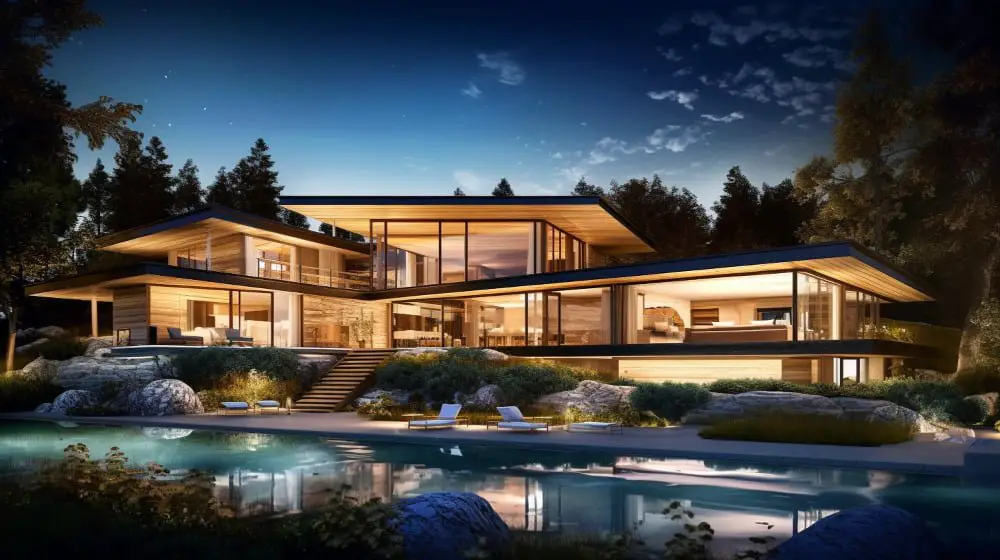
Floating roof design has emerged as a popular choice for modern villas, adding a touch of elegance and uniqueness to the overall architectural aesthetic. By creating the illusion of a roof that hovers effortlessly above the structure, this design concept can transform a simple villa into a stunning contemporary masterpiece.
The floating roof design typically involves incorporating large cantilevered sections or employing sleek architectural supports to create a sense of weightlessness. This architectural approach not only enhances the visual appeal of the villa but also allows for the inclusion of expansive glass walls, creating a seamless connection between the interiors and the surrounding landscape.
Whether set amidst lush greenery or overlooking a sparkling body of water, the floating roof design for modern villas showcases the perfect blend of practicality, innovation, and sophistication.
Multi-tiered Roofs for Tall Buildings

Multi-tiered roofs have emerged as a popular choice for tall buildings in Chinese architecture. These roofs not only add visual interest to the skyline but also serve functional purposes.
By incorporating multiple tiers, these roofs break up the height of the building, creating a sense of harmony and elegance. Additionally, the lower tiers provide platforms for rooftop gardens and terraces, offering occupants a connection to nature and stunning city views.
The use of multi-tiered roofs also allows for increased natural light and ventilation throughout the building, enhancing energy efficiency and overall comfort. This innovative design approach showcases the fusion of modern aesthetics and traditional Chinese architectural elements, making it a compelling choice for building owners and architects alike.
Extensive Use of Symmetrical Patterns On Roofs

In Chinese roof design, one notable feature is the extensive use of symmetrical patterns. These patterns, often rich in symbolism, are meticulously crafted to create a harmonious and visually pleasing aesthetic.
They can be seen on various roof components, such as the upturned eaves, ridges, and decorative supports. Whether it’s intricate floral motifs, intricate geometric patterns, or representations of mythical creatures like dragons and phoenixes, these symmetrical designs add a sense of balance and elegance to Chinese roofs.
Their careful placement and repetition reflect the emphasis on harmony and balance in traditional Chinese architecture. These symmetrical patterns not only enhance the overall visual appeal but also hold cultural significance, representing auspicious meanings and blessings for those residing beneath the roofs adorned with such exquisite detailing.





